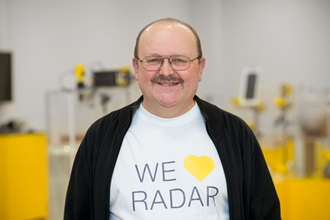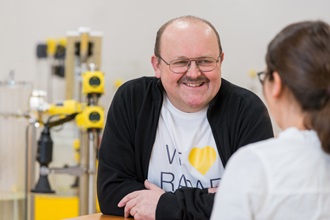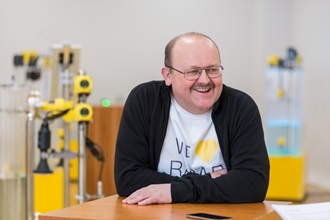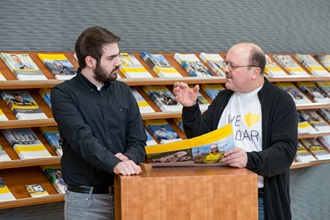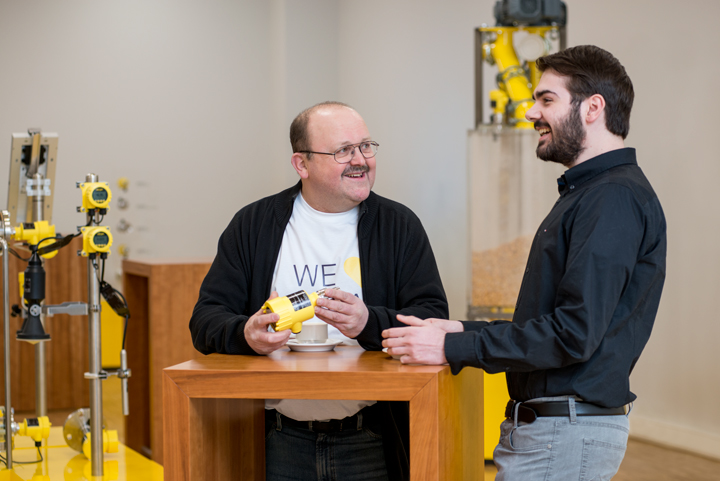Interview: Franz Harter
You’re the training manager at VEGA. How long have you been doing this job?
I've been doing this for 4 years now. I started in product management and product development, that's where, over many years I was able to learn in depth what I needed to know to deliver the best quality training.
Well, with such experience and know-how, you certainly have the ideal qualifications to be the training manager. Where does the customer training take place?
Right here in Schiltach, where we are standing. This is the exhibition space of the training area. In total we have three different training rooms, one of them is specially equipped for hands-on workshops, where participants can actually use the instruments and put into practice what they’ve learned. They remember everything better that way. That’s why we have special training courses that target the appropriate technology. Customers can also begin straight away, they don’t even need to bring their own laptop.
I've been doing this for 4 years now. I started in product management and product development, that's where, over many years I was able to learn in depth what I needed to know to deliver the best quality training.
Well, with such experience and know-how, you certainly have the ideal qualifications to be the training manager. Where does the customer training take place?
Right here in Schiltach, where we are standing. This is the exhibition space of the training area. In total we have three different training rooms, one of them is specially equipped for hands-on workshops, where participants can actually use the instruments and put into practice what they’ve learned. They remember everything better that way. That’s why we have special training courses that target the appropriate technology. Customers can also begin straight away, they don’t even need to bring their own laptop.
Do you also do training outside of Schiltach?
Yes, while some seminars are planned to take place here in Schiltach, we also offer training for our customers at their own facilities. This might be because they can’t travel here, or that several employees in one company might need training. In that case, we pack up all the equipment we need and go directly to the customer.
Yes, while some seminars are planned to take place here in Schiltach, we also offer training for our customers at their own facilities. This might be because they can’t travel here, or that several employees in one company might need training. In that case, we pack up all the equipment we need and go directly to the customer.
What is the ratio between training seminars here in Schiltach and those held at other locations?
Good question, I would say the ratio is about 50:50.
How many training seminars do you and your colleagues conduct each year?
At least one per week, sometimes two.
Now there is the new 80 GHz VEGAPULS 64. How do you do the training with this instrument?
This instrument is so important to the instrument industry, that it is actually introduced as part of every training session. But of course we also provide special training courses dealing specifically with 80-GHz radar sensors for both liquids and bulk solids.
Good question, I would say the ratio is about 50:50.
How many training seminars do you and your colleagues conduct each year?
At least one per week, sometimes two.
Now there is the new 80 GHz VEGAPULS 64. How do you do the training with this instrument?
This instrument is so important to the instrument industry, that it is actually introduced as part of every training session. But of course we also provide special training courses dealing specifically with 80-GHz radar sensors for both liquids and bulk solids.
And what does honey and Nutella have to do with these sensors?
Ah ... so word about that has gotten around. Well, here’s the scoop on that… during the training we demonstrate what real insensitivity to build up means, and honey and Nutella are extremely well suited for this purpose. Afterwards the disposal is quite simple, you can just eat it. That's why I like the topic of build up so much. :-)
Ah ... so word about that has gotten around. Well, here’s the scoop on that… during the training we demonstrate what real insensitivity to build up means, and honey and Nutella are extremely well suited for this purpose. Afterwards the disposal is quite simple, you can just eat it. That's why I like the topic of build up so much. :-)
Is there any kind of build up that VEGAPULS 64 can’t handle?
Yes, there is. An electromagnetic wave must be able to pass through something, so that it can be reflected back. In other words, the build up can just get so thick that no signal at all can get through.
However, what we’ve accomplished with VEGAPULS 64 is greatly increased dynamic range and as a result, signal attenuation, or damping, is no longer a critical factor. The instrument has much higher sensitivity than previous models with much more amplification in its electronics, so it can better detect and process weaker reflected signals. In my seminars, I always compare this capability to the human ear or eye, both of which have an incredibly large dynamic ranges. The ear's starts at about 30 dB, and we call this the hearing threshold. The audible range then extends from there to extremely loud. This is a huge dynamic range for volume detection and in principle, the VEGAPULS 64 and 69 work the same way. That’s how we get right up to 120 dB.
Then there is also a very special function that the electronics bring: STC (Sensitivity Time Control). This function ensures that unwanted reflections caused by build in the near range up are simply blocked out. It’s very impressive and represents a big step forward.
Yes, there is. An electromagnetic wave must be able to pass through something, so that it can be reflected back. In other words, the build up can just get so thick that no signal at all can get through.
However, what we’ve accomplished with VEGAPULS 64 is greatly increased dynamic range and as a result, signal attenuation, or damping, is no longer a critical factor. The instrument has much higher sensitivity than previous models with much more amplification in its electronics, so it can better detect and process weaker reflected signals. In my seminars, I always compare this capability to the human ear or eye, both of which have an incredibly large dynamic ranges. The ear's starts at about 30 dB, and we call this the hearing threshold. The audible range then extends from there to extremely loud. This is a huge dynamic range for volume detection and in principle, the VEGAPULS 64 and 69 work the same way. That’s how we get right up to 120 dB.
Then there is also a very special function that the electronics bring: STC (Sensitivity Time Control). This function ensures that unwanted reflections caused by build in the near range up are simply blocked out. It’s very impressive and represents a big step forward.
Why do you love radar?
Ahh ... love is not quite the right word, I don’t love electronic devices. I love my wife, not radar sensors. (Laugh). Okay, I guess I actually did say that.... :-)
But if we talk about why radar is my favourite, when you compare all measuring principles, you’ll discover that radar sensors are the easiest to install and operate. Adjustment, and everything else involved in setting up a measuring point, is also a lot simpler than with many other measuring principles.
Ahh ... love is not quite the right word, I don’t love electronic devices. I love my wife, not radar sensors. (Laugh). Okay, I guess I actually did say that.... :-)
But if we talk about why radar is my favourite, when you compare all measuring principles, you’ll discover that radar sensors are the easiest to install and operate. Adjustment, and everything else involved in setting up a measuring point, is also a lot simpler than with many other measuring principles.
Do you have any special memories from these past four years?
I have good memories of all my seminars, every one is interesting. What's always great is when you do a seminar at a customer site and meet some employees who have previously been to Schiltach. They start talking very enthusiastically about the seminars, facilities and the great atmosphere they experienced, that motivates others who haven’t been here yet to come as well. I always find that terrific.
I have good memories of all my seminars, every one is interesting. What's always great is when you do a seminar at a customer site and meet some employees who have previously been to Schiltach. They start talking very enthusiastically about the seminars, facilities and the great atmosphere they experienced, that motivates others who haven’t been here yet to come as well. I always find that terrific.
Export this article
Download as PDFShare this article
Comments ({{comments.length}})
This article has no comments yet. Write the first one now!
{{getCommentAuthor(comment, "Anonymous")}} {{comment.timestamp | date : "dd.MM.yyyy HH:mm" }}
{{comment.comment}}
This field is mandatory
This field is mandatory
This field is mandatory
Invalid email address
This field is mandatory
Your comment must not contain any links or email addresses
This field is mandatory
Invalid captcha
untranslated: 'Blog_SendComment_Error'

